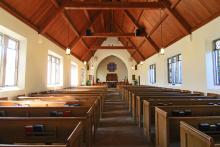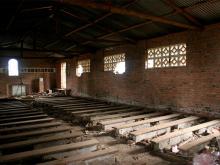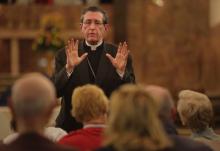church closings

The threat to churches across the country, especially churches in low-income areas, caused Justin Giboney, President of the AND Campaign, to start the Churches Helping Churches Challenge. The goal: raise $500,000 in the month of April from financially secure churches, and distribute one-time grants to small churches with financial hardship.

David Himbara, a Rwandan international development advocate based in Canada, called the government’s justification for the closures bogus and said the “real reason … is fear and paranoia.”

Our Lady of Vilnius Church, built by families of immigrant Lithuanian longshoremen, started out a century ago as a beloved worship space. Now, it’s a coveted real estate asset.
In 2013, six years after the church was closed, it was sold for $13 million to one of the city’s biggest developers. The following year, that company flipped it like a pancake to another developer for $18.4 million.
Now the yellow brick church near the entrance to the Holland Tunnel awaits demolition to make way for an 18-story luxury apartment house.
“It makes you cynical,” says Christina Nakraseive, a former parishioner who supported the legal case against the church closing until it was rejected by the state’s highest court. “It seems like it’s all about real estate.”
The issue has taken on added significance since the Roman Catholic Archdiocese of New York, citing declining attendance, rising costs, and a looming priest shortage, announced plans to merge scores of parishes and close dozens of churches this year.

I have spent much time blogging out of frustration with the church, gnashing my teeth over the church’s shortcomings. Some have called this negativity. Some have asked me to be more specific about what I want the church to do. I could not do this before. First, I needed to pinpoint my frustrations and disassemble my previous understanding of church. Out of the rubble of my own disillusionment a vision of something new is beginning to emerge. It is time to share this vision however blurry it may be.
This something new looks like congregations so committed to following Jesus by loving all of God's children that they will pour over their current budget and activities to see what can be altered to make room for greater service to the poor and the outcast. Such churches might come to the conclusion it is unconscionable to pay for the upkeep of a building for the sake of its use a few times a week.
This is a tension-filled topic. As Bergthal made public their intent to disassemble and ultimately tear down their building, many could not understand. For some, there is such a deep attachment to our church building, we would rather it be turned into a house or a barn or just anything as long as it can be saved. I have read the upcoming generation is not as sentimental when it comes to material things. I think this is a good and necessary movement but is sure to bring some tension. Finally, we must realize the church is not about buildings, but about people.

When Bishop Richard Lennon began closing 50 Catholic churches in and around Cleveland three years ago, the bulk of the faithful quietly moved on.
Some drifted to other parishes. Some didn't go to church at all. Others elected to fight for their lost sanctuaries, taking up protest signs, joining prayer vigils, signing petitions and filing appeals to the Vatican.
Many who resisted the closings worked quietly, too timid to publicly confront ecclesiastical authority, which, since childhood, they had been taught to respect.
But Patricia Schulte-Singleton was not intimidated by a Roman collar, a bishop's edict or the raised eyebrows of the obedient.

Roman Catholic Bishop Richard Lennon on Tuesday (April 17) announced that he will reopen 12 churches whose closings were reversed by the Vatican last month.
The 12 parishes had filed appeals with the Vatican after Lennon, between 2009 and 2010, closed 50 churches in the eight-county diocese, citing changes in demographics and shortages of priests and cash.

CLEVELAND--In an extraordinary move, the Vatican has reversed the closure of 13 churches in the Diocese of Cleveland, saying the parishes must be restored and the sanctuaries reopened for worship, according to activists who fought the closings.
The diocese and Bishop Richard Lennon, who ordered the closures as part of a downsizing plan in 2009 and 2010, could appeal the reversals.
The 13 parishes had filed appeals with the Vatican after Lennon closed 50 churches, citing changes in demographics and shortages of priests and cash.
Since the closings, parishioners have been swamping Rome with flurries of letters, arguing that their parishes were vibrant communities wrongfully snuffed out by the diocese.